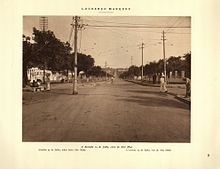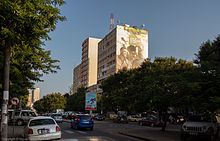Avenida 24 de Julho (Maputo)


The Avenida 24 de Julho , in English "Allee des 24. Juli", is a 4.7 kilometer long, mostly four-lane street in the Mozambican capital Maputo . It crosses downtown Maputo and connects the districts of Polana , Central , Alto Maé and Malanga . As an entry and exit road into the city center, it is one of the most important Maputos.
geography
Avenida 24 de Julho begins in the southeast of the city center at the intersection with the north-south axis, Avenida Julius Nyerere . From there it leads in a straight line to the northwest, crossing several larger streets: Avenida Salvador Allende , Avenida Amílcar Cabral , Avenida Vladimir Lenine , Avenida Karl Marx and Avenida Guerra Popular . The road joins the 16 de Junho roundabout , which in turn leads to Avenida da Organização das Nações Unidas (connection to Baixa ), Avenida da Organização da Unidade Africana (access to the motorway towards Matola) and Rua 2.019 (connection to Avenida do Trabalho ) leads.
Administrative classification
Like every street in the Mozambican capital, this one also has an administrative number. Avenida 24 de Julho runs through the two districts of KaMpfumo (1st district) and Nhlamankulu (2nd district) and therefore has the two administrative numbers "Avenida 1.092" and "Avenida 2.010"
There is no order in the country's national road network.
history
The street is one of the main axes of the city and was built as part of the Joaquim José Machados urbanization plan in 1887 together with the parallel street Avenida Pinheiro Chagas (today Avenida Eduardo Mondlane ). With the increasing urbanization of the city towards the west (spin-off of the port towards Matola ) and east (foundation of the districts Polana and Sommerschield ), the importance of the street grew. From the beginning, it bears the date of the founding of Lourenço Marques, the former name of Maputo, July 24, 1875.
While numerous names in the city disappeared in the course of Mozambique's independence, the name of the street remained - but with a shift in meaning: Since then, July 24th has stood for July 24th, 1975, the day the nationalization of the entire country was announced Economy, Education, Health and Justice.
With the economic boom after the end of the civil war in 1992, the road also gained in importance due to more traffic. In the meantime, traffic jams on the road are increasing, especially at rush hour. In 2011 there were plans to remove the median of the street and use a traffic light system to activate two lanes in each direction depending on the time of day. There were also plans to set up lanes for (semi) public transport - for TPM buses and minibuses ("Chapas"). So far, none of the plans have been implemented.
Important buildings
Along the street, especially at the beginning, there are numerous important buildings of the city. In the Polana district in particular, the street with its greenery and numerous cafés and restaurants invites you to linger. Together with the parallel street Avenida Eduardo Mondlane and the cross street Avenida Julius Nyerere, there are a large number of high-rise buildings, both older and more recent.
Polana
The Polana Shopping Center is already on the corner of Avenida Julius Nyerere , a shopping center that opened in the 2000s and one of the first in the city. Equally important are the Ministries of Education, Culture and Resistance Fighters and the National Museum of Geology , which are also located in the first part of the street. On the corner or in the Avenidas das Lusíadas is the largest bus station in the eastern city center, which is usually only called "Museu" (for the neighboring Museu de História Natural de Moçambique ). Numerous lines of the urban TPM buses and the (semi) public minibuses ("Chapas") end and begin there.
Between the side streets of Avenida Salvador Allende and Rua Dr. Almeida Ribeiro is home to the “Shopping 24” shopping center, on the corner of Avenida Amílcar Cabral is the “InterFranca” shopping center with a large supermarket run by a South African chain. The National Institute of Statistics ( Instituto Nacional de Estatística ) is also located at the same height .
Central
In the street part of the Central district is the seat of the Ministry of Labor (corner of Avenida Karl Marx ). There is also the Cine África cinema , which opened in 1948 in Art Deco style, and which today serves primarily as a venue for music and dance performances. The building of the industrial school ( Escola Industrial de Maputo) , originally built in 1929 as the seat of the colonial Masonic lodge ( Paço Maçónico ), is also remarkable .
Alto Maé
While in the eastern part of the street there is mainly higher-class and high-quality shops and restaurants, the street part in the Alto Maé district is much more complex, numerous small shops are based there. The street market on the side street Avenida da Guerra Popular also dominates the neighboring ones Streets, including Avenida 24 de Julho . On the corner of Avenida Alberto Lithuli has Aga Khan Foundation in a 1968 built prestigious building its headquarters. Two blocks away, at the Avenida Mohamed Siad Barre is the headquarters of the Pentecostal Universal Church of the Kingdom of God and the largest temple this religious community in Mozambique.
Opposite the park "Jardim 28 de Maio", which is also known colloquially as "Jardim dos Madgermanes ", is the Revolution Museum ( Museu da Revolução ). Just before Avenida da Tanzânia is the seat of the Mozambican Parliament ( Assembleia da República ).
Malanga
Behind the Avenida da Tanzânia the street crosses the border of the inner city district KaMpfumo (1st district) to the district Nhlamankulu (2nd district), right at the beginning there is the small square Largo da Malanga on the northern side of the street . The area here is mainly characterized by small, one-story houses and corrugated iron hats. After a good 900 meters, Avenida 24 de Julho joins the roundabout Praça 16 de Junho . After the roundabout, the access to the motorway begins with the junction of the EN1 national road that begins shortly afterwards . Following the direction of Avenida 24 de Julho , traffic reaches the neighboring town of Matola and on to Namaacha , Goba and Swaziland ( EN2 / EN3 ) as well as to Ressano Garcia and South Africa ( EN4 ).
Individual evidence
- ↑ Olga Maria Lopes Serrão Iglés Neves: O movimento associativo africano em Moçambique, Tradição e Luta (1926-1962). Faculdade de Ciências Sociais e Humanas, Universidade Nova de Lisboa, July 2008, p. 85 , accessed on October 22, 2014 (Portuguese, dissertation in history).
- ↑ Nomes de bairros, de praças e de ruas de Lourenço Marques e de Maputo. (No longer available online.) In: Maputo 120 anos. 2005, archived from the original on June 11, 2012 ; Retrieved October 15, 2014 (Portuguese). Info: The archive link was inserted automatically and has not yet been checked. Please check the original and archive link according to the instructions and then remove this notice.
- ↑ Tiago Valoi: Parte da avenida 24 de Julho Podera ser sentido único the seis horas às nove. In: O País. January 31, 2011, accessed October 15, 2014 (Portuguese).
- ↑ Ricardo Machava: Maputo poderá ter faixas exclusivas para transportes públicos e semi-colectivos. In: O País. July 9, 2010, accessed October 15, 2014 (Portuguese).
- ↑ Fiéis morrem na inauguração do templo da IURD. In: Moçambique para todos. March 15, 2011, accessed on October 16, 2014 (Portuguese): "via Canal Moçambique"


